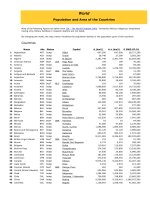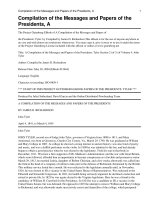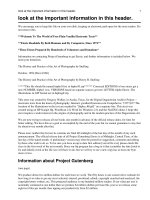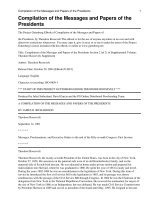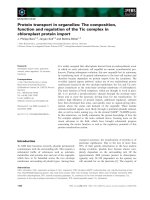Molecular function and regulation of the bax associating protein MOAP 1
Bạn đang xem bản rút gọn của tài liệu. Xem và tải ngay bản đầy đủ của tài liệu tại đây (11.68 MB, 202 trang )
PH.D. Candidature: Fu Nai Yang
Supervisor:
Assoc. Prof Victor C Yu
Degree:
M.Sc. Zhongshan Univetsity
Department:
Institute of Molecular and Cell Biology (IMCB),
Department of Pharmacology, NUS
Thesis Title:
Molecular Function and Regulation of the Bax-associating Protein MOAP-1
Year of Submission: 2007
MOLECULAR FUNCTION AND REGULATION OF
THE BAX-ASSOCIATING PROTEIN MOAP-1
Fu Nai Yang
INSTITUTE OF MOLECULAR AND CELL BIOLOGY
NATIONAL UNIVERSITY OF SINGAPORE
2007
MOLECULAR FUNCTION AND REGULATION OF
THE BAX-ASSOCIATING PROTEIN MOAP-1
Fu Nai Yang
(M.Sc., Zhongshan Univ.)
A THESIS SUBMITTED
FOR THE DEGREE OF DOCTOR OF PHILOSOPHY
INSTITUTE OF MOLECULAR AND CELL BIOLOGY
NATIONAL UNIVERSITY OF SINGAPORE
2007
i
ACKNOWLEDGMENTS
I would like to express my deepest gratitude to my supervisor, Associate Professor
Victor C. Yu, for his guidance, support and encouragement all these years.
My sincere thanks also go to my graduate supervisory committee, Drs. Alan G Porter
and Thomos Leung for their constructive suggestions and critical comments.
Many thanks to the past and present colleagues in VY lab for sharing reagents,
information, helpful discussion, cooperation, friendship, and technical support. Special
thanks to Drs. Tan KO, Sukumaran Sunil SK, Chan SL, Yee KL for their great help.
It is my great pleasure to express my thanks to IMCB for giving me the opportunity to
pursue my Ph.D. research work and providing the wonderful resources to make my work
possible.
My hearfelt appreciation goes to my family and personal friends for the support and
understanding throughout these years.
ii
TABLES OF CONTENTS
SUMMARY
ABBREVIATION
LIST OF FIGURES
LIST OF TABLES
INTRODUCTION
1.1 APOPTOSIS 1
1.1.1 Definition and morphology of apoptosis 1
1.1.2 Extrinsic and intrinsic pathways of apoptosis 3
1.1.3 Apoptosis and human diseases 5
1.2 MITOCHONDRIA AS THE CENTRAL ORGANELLES FOR REGULATING
APOPTOSIS SIGNALING 6
1.2.1 Mitochondria 6
1.2.2 Discovery of the involvement of mitochondria in apoptosis 8
1.2.3 Release of apoptogenic factors from mitochondria during apoptosis 9
1.3 BCL-2 FAMILY PROTEINS: LIFE-AND-DEATH SWITCH IN MITOCHONDRIA 14
1.3.1 Discovery of Bcl-2 as an oncogene 14
1.3.2 The Bcl-2 family 16
1.3.2.1 Bcl-2 homolog (BH) domains 16
1.3.2.2 Three classes of the Bcl-2 family
18
1.3.2.3 Models for the functional interplay among Bcl-2 family in apoptosis signaling
22
1.3.2.4 Knockout studies among the Bcl-2 family genes
29
1.3.3 Regulation of mitochondrial outer membrane permeability by the Bcl-2 family 33
1.3.3.1 Regulation of MPT 33
1.3.3.2 Regulation of a putative VDAC-dependent protein-releasing pore
35
1.3.3.3 Channel formation
38
iii
1.4 THE MULTIDOMAIN PRO-APOPTOTIC PROTEIN BAX AND BAK 41
1.4.1 Bax plays dominant role over Bak 41
1.4.2 Regulation of Bax function 42
1.5 REGULATION OF MITOCHONDIA-DEPENDENT APOPTOSIS BY THE
UBIQUITIN-PROTEASOME SYSTEM 47
1.5.1 The ubiquitin-proteasome system 47
1.5.2 Regulation of Bcl-2 family proteins by UPS 51
1.6 OBJECTIVES OF THIS STUDY 53
MATERIALS AND METHODS 55
2.1 CHEMICAL AND REAGENTS 55
2.1.1 Chemical 55
2.1.2 Commercial antibodies 55
2.2 MOLECULAR BIOLOGY TECHNIQUES AND METHODS 55
2.2.1 Plasmid construction 55
2.2.2 Preparation of heat shock E.Coli competent cells 56
2.2.3 Plasmid DNA transformation 57
2.2.4 Agarose gel electrophoresis 57
2.2.5 Restriction enzyme digestion of DNA 57
2.2.6 DNA ligation 58
2.2.7 Purification of DNA fragments 58
2.2.8 Plasmid DNA sequencing 58
2.2.9 Polymerase chain reaction (PCR) 59
2.2.10 Site-directed mutagenesis 59
2.2.11 Mini-preparation of plasmid DNA 60
2.2.12 Maxi-preparation of plasmid DNA 60
2.2.13 RNA extraction, cDNA preparation and RT-PCR 61
2.3 MAMMALIAN CELL CULTURE, GENERATION OF STABLE CELL LINE,
DRUG TREATMENT AND APOPTOTIC ASSAY 61
2.3.1 Mammalian cell culture 61
2.3.2 Transfection of mammalian cell 62
2.3.3 Generation of stable cell line 62
iv
2.3.4 Drug treatment 63
2.3.5 Apoptotic assay 63
2.4 PROTEIN METHODOLOGY 64
2.4.1 Cell lysate preparation, immunoprecipitation and western blotting 64
2.4.2 SDS-PAGE gel electrophoresis 65
2.4.3 Determination of protein half-life in vivo 65
2.4.4 Subcellular fractionation 66
2.4.5 Analysis of sub-mitochondrial localization of protein 66
2.4.6 In vitro Cytochrome c release from isolated mitochondria 67
2.4.7 Association of in vitro-translated proteins with isolated mitochondria 67
2.4.8 In vitro transcription and translation of protein 67
2.4.9 Expression and purification of bacterial-expressed recombinant proteins 67
2.4.10 Bax oligomeration analysis by FPLC 69
2.4.11 Indirect Immunofluorescence (IF) 69
2.4.12 Generation of in house antibodies 70
RESULTS 71
3.1 MOAP-1 IS REQUIRED FOR BAX-MEDIATED APOPTOSIS
SIGNALING IN MITOCHONDRIA 71
3.1.1 MOAP-1 is enriched in the mitochondrial outer membrane 71
3.1.2 MOAP-1 is integrated into the mitochondrial membrane and associates with
Bax during apoptosis 73
3.1.3 MOAP-1 is required for Bax-induced apoptosis signaling 75
3.1.4 Silencing MOAP-1 in mammalian cells confers resistance
to diverse apoptotic stimuli 77
3.1.5 Conformation change and translocation of Bax triggered by apoptotic stimuli
are inhibited in MOAP-1 deficient cells 81
3.1.6 MOAP-1 has a direct role in facilitating Bax function in releasing apoptogenic
factors from mitochondria 84
3.1.7 Stable expression of MOAP-1 restores the phenotypes associated with
MOAP-1 knockdown 88
3.1.8 Conclusions 89
3.1.9 Acknowledgement 91
v
3.2 INHIBITION OF UBIQUITIN-MEDIATED DEGRADATION OF MOAP-1 BY
APOPTOTIC STIMULI PROMOTES BAX FUNCTION IN MITOHCONDIRA 92
3.2.1 MOAP-1 protein in mammalian cells is rapidly up-regulated by multiple
apoptotic stimuli 92
3.2.2 Apoptotic stimuli stabilize MOAP-1 protein 99
3.2.3 MOAP-1 protein is selectively up-regulated by proteasome inhibitors 103
3.2.4 MG-132 induced MOAP-1 accumulation in mitochondria
and its association with Bax 107
3.2.5 Apoptotic stimuli inhibit poly-ubiquitination of MOAP-1 which is required for
its degradation 109
3.2.6 The center domain of MOAP-1 is required and sufficient for mediating its
degradation by UPS 111
3.2.7 Elevating MOAP-1 protein levels sensitizes mammalian cells to apoptotic stimuli 114
3.2.8 MOAP-1 is a key short-lived protein required for Bax function in mitochondria 117
3.2.9 Conclusions 120
3.2.10 Acknowledgement 121
DISCUSSION 122
4.1 MOAP-1 IS A MITOCHONDRIAL EFFECTOR OF BAX 122
4.2 MITOCHONDRIAL PRO-APOPTOTIC FUNCTION OF BAX IS REGULATED
BY UPS THROUGH CONTROLING MOAP-1 PROTEIN LEVELS 125
4.3 FUTURE PERSPECTIVE 135
REFERENCE LIST 136
vi
SUMMARY
Apoptotic stimuli induce conformational changes of Bax and trigger its translocation
from cytosol to mitochondria. Upon assembling into the mitochondrial outer membrane,
Bax initiates a death program through a series of events, culminating in the release of
apoptogenic factors such as Cytochrome c. Although it is known that Bax is one of the key
factors for integrating multiple death signals, the mechanism by which Bax functions in
mitochondria remains controversial. MOAP-1, initially named MAP-1 (M
odulator of
Ap
optosis-1), has previously been cloned as a Bax-associating protein from an yeast two-
hybrid screen using Bax as bait. It is known that MOAP-1 is a low-abundance protein and
is pro-apoptotic when over-expressed, but its functional relationship with Bax in
contributing to apoptosis signaling as well as its molecular regulation during apoptosis
remain unclear.
In this study, MOAP-1 was first demonstrated to be a mitochondria-enriched protein
that associates with Bax only upon apoptotic induction. Small interfering RNAs (siRNA)
that diminish MOAP-1 levels in mammalian cell lines confer selective inhibition of Bax-
mediated apoptosis. Mammalian cells with stable expression of MOAP-1 siRNA are
resistant to multiple apoptotic stimuli in triggering apoptotic death as well as in inducing
conformation change and translocation of Bax. Remarkably, recombinant Bax- or tBid-
mediated release of Cytochrome c from isolated mitochondria is significantly
compromised in the MOAP-1 knockdown cells. These data together suggest that MOAP-1
is a critical effector for Bax function in mitochondria.
vii
During characterization of the role of MOAP-1 in apoptosis signaling in mammalian
cells, it was discovered that MOAP-1 protein can be rapidly up-regulated by multiple
apoptotic stimuli. Further investigation reveals that MOAP-1 is a short-lived protein (t
1/2
=
25 min) that is constitutively degraded by the ubiquitin-proteasome system. Proteasome
inhibitors are capable of dramatically extending the half-life of MOAP-1 and promote the
accumulation of poly-ubiquitinated forms of MOAP-1 in a variety of mammalian cell
lines. Interestingly, induction of MOAP-1 by apoptotic stimuli ensues through inhibition
of its poly-ubiquitination process. Deletion analysis suggests that the center region (a.a.
141-190) of MOAP-1 is required and sufficient for coupling MOAP-1 and other unrelated
proteins such as GST for ubiquitin-mediated degradation. Mammalian cells have low
basal levels of MOAP-1 and elevation of MOAP-1 levels sensitizes cells to apoptotic
stimuli and promotes recombinant Bax-mediated Cytochrome c release from isolated
mitochondria. Mitochondria depleted of short-lived proteins by cycloheximide become
resistant to recombinant Bax-mediated Cytochrome c release. Remarkably, incubation of
these mitochondria with in vitro-translated MOAP-1 effectively restores the Cytochrome c
releasing effect of recombinant Bax. These data not only lend further support to the idea
that MOAP-1 plays an effector role for Bax function in mitochondria as suggested from
MOAP-1 RNAi knockdown study, but also raise an intriguing possibility that MOAP-1
could be the key short-lived mitochondrial protein that is required for mediating Bax
function in mitochondria.
Identification of MOAP-1 as a mitochondrial effector for Bax and a substrate for the
ubiquitin-proteasome system would thus afford the opportunity for conceptualizing novel
therapeutic strategies aimed at altering functional activity of Bax in mitochondria.
viii
ABBREVIATION
AIDS Acquired immunodeficiency syndrome
AIF Apoptosis- inducing factor
Apaf-1 Apoptotic protease activating factor-1
Bad Bcl-xL/Bcl-2-associated death promoter
Bak Bcl-2 homologous antagonist/killer
Bax Bcl-2-associated x protein
Bcl-2 B-cell lymphoma/leukemia-2
Bcl-xL, Bcl-xS Bcl-2 related protein, L=long transcript, S=short transcript
BH domain Bcl-2 homology domain
BIR Baculovirus IAP repeat
Bok Bcl-2 related ovarian killer
Boo Bcl-2 ovary homologue
CAM Camptothecin
C. elegans Caenorhabditis elegans
Caspase Cysteinyl aspartate-specific protease
ced-3, -4 and –9 Cell death abnormal 3, 4 and 9
CHAPS 3-[(3-cholamidopropyl)dimethylammonio]-1-propane-sulfonate
CHX Cycloheximide
Diablo Direct IAP binding protein with low isoelectric point
DMEM Dulbecco’s modified Eagle’s medium
DTT Dithiothreitol
EDTA Ethylenediaminetetraacetate
ix
egl-1 Egg laying defective-1
ER Endoplasmic reticulum
ETOP Etoposide
FBS Fetal bovine serum
FITC Fluorescein isothiocyanate
G418 Geneticin
GFP Green fluorescent protein
GST Glutathione S-transferase
HA Hemagglutinin
HEPES N-2-hydroxyethyl peperazine-N’-2-ethanesulfonic acid
HRP Horseradish peroxidase
IAP Inhibitor-of-apoptosis protein
IPTG Isopropyl-β-D-thiogalactopyranosid
LB: Luria-Bertani
MEF Mouse embryo fibroblast
MG132 Carbobenzoxyl- leucinyl- leucinyl- leucinal-H
NP-40 Nonidet P-40
PARP Poly(ADP-ribose) polymerase
PCD Programmed cell death
PI Propidium iodide
PTP Permeability transition pore
RT Room temperature
RNAi RNA interfering
SDS Sodium dodecylsulfate
x
siRNA Small interfering RNA
Smac Second mitochondria-derived activator of caspase
STS Staurosporine
TM Transmembrane domain
TNF Tumor necrosis factor
THA Thapsgargin
TRAIL TNF-related apoptosis-inducing ligand
UPS Ubiquitin-proteasome system
XIAP X-chromosome-linked inhibitor of apoptosis protein
Z-DEVD-fmk N-benzyloxycarbonyl-Asp-Glu-Val-Asp-fluoromethylketone
Z-VAD-fmk N-benzyloxycarbonyl-Val-Ala-Asp-fluoromethylketone
xi
LIST OF FIGURES
Figure 1.1 Morphology changes during apoptosis.
Figure 1.2 Extrinsic versus intrinsic caspase activation cascades.
Figure 1.3 Mitochondrial architecture.
Figure 1.4 Cytochrome c–mediated caspase activation.
Figure 1.5 Release of apoptogenic factors from mitochondria and their involvement
in caspase-dependent and independent apoptosis pathways.
Figure 1.6 Chromosomal translocation of the Bcl-2 gene.
Figure 1.7 Sequence alignment of Bcl-2 family proteins.
Figure 1.8 Classification of the Bcl-2 family proteins based on conservation of BH domains.
Figure 1.9 Two proposed models for Bcl-2 survival activity.
Figure 1.10 Diverse cellular signaling pathways activate the apoptotic program through
recruiting distinct BH3-only proteins to engage downstream multidomain
Bcl-2 family members.
Figure 1.11 Differential binding profiles of BH3-only proteins to the anti-apoptotic
Bcl-2 family members and their apoptotic potency.
Figure 1.12 Models for the functional interplay among the Bcl-2 family proteins in
mammalian cells.
Figure 1.13 Release of mitochondrial apoptogenic factors by formation of apoptotic
protein-conducting pores during apoptosis or MPTP during necrosis.
Figure 1.14 VDAC as a convergence point for a variety of death-signals.
Figure 1.15 The structures of the Bcl-2 proteins show a striking similarity to the
pore-forming domains of bacterial colicins.
Figure 1.16 Comparison of pore-forming models for Bax.
Figure 1.17 Model for the mechanism of activation of Bax.
xii
Figure 1.18 The ubiquitin-proteasome system.
Figure 3.1.1 MOAP-1 protein is enriched in mitochondrial outer membrane.
Figure 3.1.2 MOAP-1, together with Bax, is integrated into mitochondrial membrane
during apoptosis.
Figure 3.1.3 Knockdown efficiency of various RNAi constructs targeting different
regions of MOAP-1 mRNA.
Figure 3.1.4 MOAP-1 is required for Bax-induced apoptosis.
Figure 3.1.5 MOAP-1 Knockdown MCF-7 Cells are resistant to diverse apoptotic
stimuli.
Figure 3.1.6 MOAP-1 deficient HCT116 cells exhibit resistance to apoptotic stimuli.
Figure 3.1.7 GFP-Bax activation and translocation induced by TNF are compromised
in MOAP-1 knockdown cells.
Figure 3.1.8 Apoptotic stimuli-mediated conformation changes, translocation as well
as oligomeization of endogenous Bax, and the release of Cytochrome c
are all suppressed in MOAP-1 depleted Cells.
Figure 3.1.9 Recombinant Bax proteins exist as onligomers and in an active
conformation.
Figure 3.1.10 Mitochondria isolated from MOAP-1 deficient MCF-7 cells are resistant
to Bax- and tBid-mediated release of Cytochrome c from isolated
mitochondria.
Figure 3.1.11 Mitochondria from MOAP-1 deficient HCT116 cells are resistant to recombinant
Bax- or tBid-mediated release of cytochrome c.
Figure 3.1.12 Stable expression of MOAP-1 rescues the phenotypes associated
with MOAP-1knockdown
xiii
Figure 3.2.1 Levels of endogenous MOAP-1 protein are rapidly up-regulated by TRAIL
in mammalian cells.
Figure 3.2.2 THA rapidly elevates MOAP-1 protein levels in mammalian cells.
Figure 3.2.3 Up-regulation of MOAP-1 by ETOP during the early phase of
apoptosis signaling is through a caspase-independent mechanism.
Figure 3.2.4 STS is able to trigger apoptosis, but failed to induce the up-regulation of
MOAP-1 protein.
Figure 3.2.5 DNA-damaging stimuli up-regulate MOAP-1 protein.
Figure 3.2.6 Up-regulated MOAP-1 protein by ETOP was mainly detected in the
mitochondria-enriched fraction.
Figure 3.2.7 Up-regulation of MOAP-1 at the early stage of apoptosis is reversible.
Figure 3.2.8 Up-regulation of MOAP-1 is through a post-translational mechanism.
Figure 3.2.9 MOAP-1 is a short-lived protein in various mammalian cell Lines.
Figure 3.2.10 MOAP-1 is a short-lived protein that can be stabilized by apoptotic stimuli.
Figure 3.2.11 Proteasome inhibitors enhanced MOAP-1 protein levels.
Figure 3.2.12 The 37 KD protein up-regulated by proteasome inhibitors can be detected
by various anti-MOAP-1 antibodies.
Figure 3.2.13 MG132 up-regulates MOAP-1 through extending its half-life.
Figure 3.2.14 ETOP-induced MOAP-1 up-regulation is not be further increased by MG132.
Figure 3.2.15
MOAP-1 accumulation in mitochondria and its association with Bax accompany
proteasome inhibitor-induced apoptosis.
Figure 3.2.16 Apoptotic stimuli suppress poly-ubiquitination of MOAP-1.
Figure 3.2.17 The center domain of MOAP-1 is responsible for mediating its degradation
by UPS.
Figure 3.2.18 The degradation signal in the center domain of MOAP-1 is transferable.
xiv
Figure 3.2.19 Higher levels of MOAP-1 sensitize HCT116 cells to multiple
apoptotic stimuli.
Figure 3.2.20 Higher levels of MOAP-1 sensitize MCF-7 Cells to apoptotic stimuli.
Figure 3.2.21 MOAP-1 is a key short-lived protein required for recombinant Bax-mediated
Cytochrome c release from isolated mitochondria.
Figure 4.1 Lysine residues in MOAP-1 protein.
Figure 4.2 RASSF1 family proteins stabilize MOAP-1.
xv
LIST OF TABLES
Table 1.1 Differential features and significance of necrosis and apoptosis.
Table 1.2 Identification of Bcl-2 family members.
Table 1.3 Knockout phenotypes among different Bcl-2 family members.
Table 4.1 MOAP-1 plasmids with lysine to arginine mutations.
xvi
PUBLICATION LIST
1. Fu NY, Sukrmaran SK. and Yu VC. Inhibition of Ubiquitin-mediated Degradation of MOAP-
1 by Apoptotic Stimuli Promotes Bax Function in Mitochondria. Proc Natl Acad Sci USA (2007)
104: 10051-1005.
2. Tan YX, Tan TH, Lee MJ, Tham PY, Gunalan V, Druce J, Birch C, Catton M, Fu NY, Yu VC,
Tan YJ. Induction of Apoptosis by the Severe Acute Respiratory Syndrome Coronavirus 7a
Protein Is Dependent on Its Interaction with the Bcl-XL Protein. J. Virol. (2007) 81: 6346-6355.
3. Tan KO, Fu NY, Sukumaran SK, Chan SL, Kang JH, Poon KL, Chen BS, Yu VC. MAP-1 is a
mitochondrial effector of Bax. Proc Natl Acad Sci USA. (2005) 102: 14623-14628.
4. Chan SL, Lee MC, Tan KO, Yang LK, Lee AS, Flotow H, Fu NY, Butler MS, Soejarto DD,
Buss AD, Yu VC. Identification of chelerythrine as an inhibitor of BclXL function. J. Biol. Chem.
(2003) 278: 20453-20456.
5. Tan KO, Chan SL, Fu NY, Yu VC. MAP-1 is a putative ligand for the multidomain domain
proapoptotic protein BAX. Programmed Cell Death (2003), eds: Y. Shi, J.A. Cidlowski, D. Scott
and Y.B. Shi, Kluwer Academic/Plenum Publishers.
xvii
CONFERENCE POSTERS
1. Lee SS, Fu NY, Wan KF, Yu VC. TRIM39 IS A NOVEL REGULATOR OF MOAP-1 IN
MAMMALIAN CELLS. Cell Death (Cold Spring Harbor Laboratory, USA, 2007).
2. Sukumaran SK, Fu NY, Chua BT, Wan KF, Lee SS, Yu VC. BACTERIAL PATHOGEN–
HOST CELL INTERACTION AS AN EXPERIMENTAL PARADIGM FOR INVESTIGATING
THE CORE MECHANISM OF APOPTOSIS SIGNALING IN MITOCHONDRIA. Cell Death
(Cold Spring Harbor Laboratory, USA, 2007).
3. Fu NY, Sukumaran SK and Victor C. Yu. Apoptotic stimuli promote Bax function in
mitochondria via inhibition of ubiquitin-dependent degradation of MOAP-1. Apoptotic and Non-
apoptotic Cell Death Pathway (Keystone Symposia, USA, 2007).
4. Fu NY, Tan KO, Sukumaran SK and Yu VC. MAP-1 is a critical mitochondrial effector of
Bax function and it is highly regulated by the ubiquitin-proteasome pathway. Programmed Cell
Death (Cold Spring Harbor Laboratory, USA, 2005).
Introduction
-1-
INTRODUCTION
1.1 APOPTOSIS
1.1.1 Definition and morphology of apoptosis
Apoptosis, the dominant form of programmed cell death, refers to the shedding of
leaves from trees in Greek. The distinct morphological changes of cells undergoing
apoptosis are characterized by shrinkage of the cell, hypercondensation of chromatin,
cleavage of chromosomes into nucleosomes, violent blebbing of the plasma membrane
without rupture and packaging of cellular contents into membrane-enclosed vesicles called
‘apoptotic bodies’ (Figure 1.1 and Table 1.1) (Kerr et al., 1972; Hacker, 2000). In vitro,
apoptotic cells ultimately swell and become permeable to PI staining, resulting in the so-
called “secondary necrosis” phase (Mills et al., 1999; Hacker, 2000; Desagher &
Martinou, 2000), whereas, in vivo, they are recognized and removed by either phagocytes
or adjacent cells, thereby avoiding inappropriate inflammation. DNA degradation into
oligonucleosomal fragments by engonuleases is one of the classical biochemical hallmarks
of apoptosis (Wyllie, 1980; Janicke et al., 1998; Hacker, 2000; Desagher & Martinou,
2000). Genetic and biochemical studies in Caenorhabditis elegans, Drosophila
melanogaster and mammals have led to the identification of the main players of the cell
death machinery and have shown that this process has been conserved throughout
evolution (Vaux & Strasser, 1996; Strasser et al., 2000). The collapse of the cell is brought
about by the action of aspartate-specific cysteine proteases termed caspases (Thornberry &
Lazebnik, 1998; Porter & Janicke, 1999). Caspases are normally present in healthy cells as
zymogens with low or no enzymatic activity (Porter, 2006). They become activated
Introduction
-2-
Figure 1.1 Morphology changes during apoptosis. (A) Healthy control cells; (B) Chromatin condensation
as a whole; (C) Chromatin condensation in the nucleus; (D) Fragmentation of Chromatin in the cytosol; (E)
Formation of apoptotic body; (F) Secondary necrosis. Cells were stained with HO33342 and PI.
Table 1.1 Differential features and significance of necrosis and apoptosis.
Necrosis Apoptosis
Morphological features
· Loss of membrane integrity · Membrane blebbing, but no loss of integrity
· Flocculation of chromatin · Aggregation of chromatin at the nuclear membrane
· Swelling of the cell and lysis · Cellular condensation (cell shrinkage)
· No vesicle formation, complete lysis · Formation of membrane bound vesicles (apoptotic bodies)
·Disintegation (swelling of organelles) · No disintegration of organelles; organells remain intact
Biochemical features
· Loss of regulation of ion homeostasis · Tightly regulated process involving activation and enzymatic steps
· No energy requirement (passive
process, also occurs at 4
0
C)
· Energy(ATP)-dependent (active process, does not occur at 4
0
C)
· Random digestion of DNA (Smear of
DNA after agarose gel electrophoresis)
· Non-random mono-and oligonucleosomal length fragmentation of
DNA (Ladder pattern after agarose gel electrophoresis)
· Postlytic DNA fragmentation (= late
event of death)
· Prelytic DNA fragmentation (= early event of cell death)
Caspase activation No caspase activation
Physiological significance
· Death of cell groups · Death of single, individual cells
· Evoked by non-physiological
disturbances
· Induced by physiological stimuli
· Phagocytosis by macrophages · Phagocytosis by adjacent cells or macrophages
· Significant inflammatory response · No inflammatory response
Introduction
-3-
through proteolysis via autocatalytic processing (initiator caspases such as Caspase 8 and
9) or by already active caspases (effector caspases such as Caspase 3 and 7) (Adams &
Cory, 2002; Ho & Zacksenhaus, 2004).
1.1.2 Extrinsic and Intrinsic pathways of apoptosis
Two types of signaling pathway have been identified to mediate apoptosis (Figure
1.2). The initiation and amplification of caspase cascades are involved in both pathways
(Kroemer et al., 2007). The “extrinsic” pathway begins with the interaction between
various cell death receptors and their corresponding ligands or agonist, resulting in the
formation of membrane bound and muticomponent death inducing signaling complex
(DISC). DISC further recruits and induces auto-proteolytic activation of initiator caspases,
such as caspase 8 or caspase 10 (Adams & Cory, 2002; Ho & Zacksenhaus, 2004). These
activated initiator caspases trigger cell death by directly or indirectly activating
downstream executioner caspases, such as caspase 3 and caspase 7. The “intrinsic”
pathway is stimulated by noxious factors, such as DNA damage, unbalanced proliferative
stimuli, and nutrient or energy depletion. The execution phase of this pathway is initiated
by the release of Cytochrome c and other apoptogenic factors from mitochondrial
intermembrane space (Li et al., 2004). Cytochrome c binds to the adaptor molecule
apoptotic protease activating factor (Apaf-1) in the presence of ATP or dATP and form a
large complex named as apoptosome. The apoptosome then recruits caspase 9 and trigger
its activation by auto-cleavage (Jiang & Wang, 2004). Activated caspase can, in turn,
directly activate downstream executioner caspases and trigger apoptosis.
Introduction
-4-
As mentioned above, the initiation of early capsase activation is different between the
“extrinsic” and “intrinsic” pathways. Although in certain cell types, the “extrinsic” or cell
death receptor mediated pathway does not require mitochondria involvement to activate
executioner capsases, the extrinsic and intrinsic death pathways converge on mitochondria
in most cell types (Green & Kroemer, 2004). Therefore, for most of mammalian cells, as
discussed below in detail, mitochondria play a central role in controlling apoptosis events
by integrating upstream apoptosis-inducing (proapototic) signals and regulating the release
of apoptogenic factors. Bid, a Bcl-2 member, serves as one of linkers between “extrinsic”
and “intrinsic” apoptosis pathways (Figure 1.2).
Figure 1.2 Extrinsic versus intrinsic caspase activation cascades (Adapted from Kroemer et al., 2007).
Left: extrinsic pathway. The ligand-induced activation of death receptors induces the assembly of the death-
inducing signaling complex (DISC) on the cytoplasmic side of the plasma membrane. This promotes the
Introduction
-5-
activation of caspase-8 (and possibly of caspase-10), which in turn is able to cleave effector caspase-3, -6,
and -7. Caspase-8 can also proteolytically activate Bid, which promotes mitochondrial membrane
permeabilization (MMP) and represents the main link between the extrinsic and intrinsic apoptotic
pathways. The extrinsic pathway includes also the dependency receptors, which deliver a death signal in the
absence of their ligands, through yet unidentified mediators. Right: intrinsic pathway. Several intracellular
signals, including DNA damage and endoplasmic reticulum (ER) stress, converge on mitochondria to induce
MMP, which causes the release of proapoptotic factors from the intermembrane space (IMS). Among these,
Cytochrome c (Cyt c) induces the apoptosis protease-activating factor 1 (APAF-1) and ATP/dATP to
assemble the apoptosome, a molecular platform which promotes the proteolytic maturation of caspase-9.
Active caspase-9, in turn, cleaves and activates the effector caspases, which finally lead to the apoptotic
phenotype. DNA damage may signal also through the activation of caspase-2, which acts upstream
mitochondria to favor MMP. See section IIA for further details.
1.1.3 Apoptosis and human diseases
Apoptosis, the dominant form of programmed cell death, plays a critical role in
controlling the number of cells in development and throughout the life of multicellular
organisms by removing unwanted, damaged and infected cells at the appropriate time.
Alterations of this normal process can result in the disruption of the delicate balance
between cell proliferation and cell death and can lead to a variety of diseases (Thompson,
1995; Fischer & Schulze-Osthoff, 2005). Increased apoptosis has been associated with
acute ischemic diseases associated with reperfusion injury, such as myocardial infarction,
stroke and renal hypoxia. Inappropriate apoptosis also contributes to several neurologic
disorders. In Alzheimer’s, Parkinson’s and Huntington’s disease, specific neurons
prematurely commit suicide, which can lead to irreversible memory loss, uncontrolled
muscular movements and depression (Nijhawan et al, 2000; Vila & Przedborski, 2003).
Involvement of increased apoptosis in arteriosclerosis, infertility, heart failure, AIDS,
diabetes and hepatitis have also been reported (Thompson, 1995; Fischer & Schulze-
